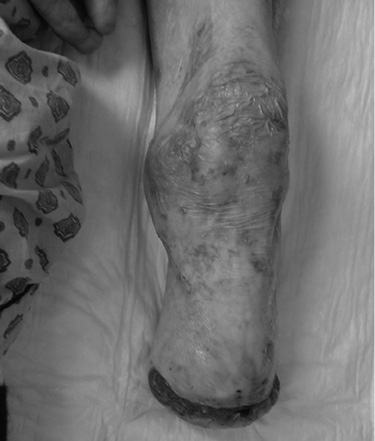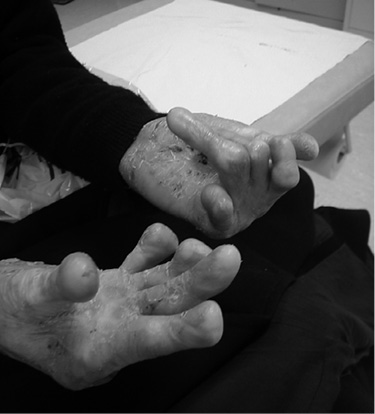André Thevenon, MD1,4, Marguerite Preud’homme, MD1, Philippe Patenotre, MD2, Benoit Catteau3, MD, Anne Blanchard-Dauphin, MD1, Valérie Wieczorek, MD1 and Vincent Tiffreau, PhD1,4
From the 1Service de Médecine Physique et Réadaptation, 2Service de Chirurgie Adulte Ouest, 3Service de Dermatologie, CHRU and 4EA 4488, Université Nord de France, Faculté de Médecine, Lille, France
OBJECTIVE: Dystrophic epidermolysis bullosa is a rare disease characterized by widespread blistering of the skin and mucous membranes, which may ultimately prompt limb amputation. In this context, the outcome of fitting a prosthesis to a chronically wounded stump is not well known. Our patient’s experience (with 15 years of follow-up) should contribute to better knowledge of this topic.
CASE REPORT: A 37-year-old man presented with severe dystrophic epidermolysis bullosa. Recurrent skin carcinoma had led to an amputation below the knee. Despite incessant development of blisters on the stump and the need for wound dressing and padding, the patient has been able to walk freely with a prosthesis and a cane. A large number of skin sarcomas were excised over the 15-year period of prosthesis use. Two falls have resulted in limb fractures. A new sarcoma on the stump marked the end of the use of the prosthesis.
Discussion: Despite the constant presence of wounds on the stump, amputees with dystrophic epidermolysis bullosa can successfully be fitted with a prosthesis.
Key words: leg amputation; epidermolysis bullosa; skin carcinoma.
J Rehabil Med 2016; 48: 00–00
Correspondence address: André Thevenon, Médecine Physique et de Réadaptation, University hospital, FR-59000 Lille, France. E-mail: andre.thevenon@chru-lille.fr
Accepted Jun 1, 2016; Epub ahead of print Aug 18, 2016
INTRODUCTION
Severe, generalized dystrophic epidermolysis bullosa (DEB), formerly known as Hallopeau Siemens dystrophic epidermolysis bullosa, is an autosomal-recessive disease characterized by widespread blistering of the skin and mucous membranes (1). Skin carcinoma (and especially squamous cell carcinoma; SCC) is a major complication of this disease, affecting over 66% of patients by the age of 35 years and approximately 90% by the age of 55 years (2). Skin carcinoma may lead to limb amputation, with uncommon fitting problems of a chronically wounded stump. Our patient’s experience (with 15 years of follow-up) should contribute to better knowledge of this topic.
CASE REPORT
We report here a case of a man with severe, generalized DEB, immunoglobulin A (IgA) glomerulonephritis and anaemia; conditions that are known to be frequently associated (3). The patient was 32 years old when the first carcinomas appeared (on both ankles, the distal third of the left leg and the left hand). These carcinomas were resected. The leg tumour recurred 3 years later and was not fully eliminated by resection. The patient initially refused amputation of the affected leg. Although radiotherapy was then initiated as an alternative treatment, the occurrence of life-threatening bleeding (due to erosion of the anterior tibial artery by the tumour) prompted the patient to agree to amputation of the distal third of the leg.
The patient was 37 years old when he was admitted to our rehabilitation department 3 days after amputation, with an open wound at the end of the stump (Fig. 1). He also presented with a 20° flexion contracture of the knee and 5° knee varus. The patient’s extremely low body fat percentage meant that his bony protuberances were particularly prominent.

Fig. 1. An open wound at the end of the stump, and lesions resulting from severe, generalized dystrophic epidermolysis bullosa (DEB).
After several weeks of treatment with simple dressings and an elastic compression stocking, the wound healed and the stump’s volume stabilized. There was no change in the 20° flexion contracture of the knee.
New blisters appeared on the stump on a regular basis and were treated by applying silver sulfadiazine and gauze. In view of the patient’s very particular skin condition, we prescribed a prosthesis with a carbon socket, a silicone liner with distal attachment, a distal cup liner, and a Sure Flex® foot (Össur, Reykjavik, Iceland). Even though blisters or de-epidermised lesions appeared on a daily basis, indiscriminate of pressure zones, use of this type of prosthesis enabled the patient to apply the dressings himself. Despite the use of the prosthesis, the wounds healed and the patient was soon able to walk without limitation with the aid of a walking stick. The stick’s handle was initially customized to take into account the patient’s hand deformities (as a result of distal amputations) (Fig. 2). Limited household ambulation without a stick was possible.

Fig. 2. Hand deformities.
The course of the disease was marked by the recurring development of carcinoma at various sites (notably the neck, several parts of the trunk, the distal part of the right leg, and the right shoulder). Eleven resections were performed (together with skin grafts, in some cases) in the 15 years following the amputation. Repeated surgery, chronic anaemia and the intractable pain caused by some lesions (especially those on the trunk) progressively worsened the patient’s general condition.
The patient self-reported multiple falls. Two falls were complicated by a bone fracture in the remaining leg. Firstly, a pertrochanteric fracture occurred 7 years after amputation and was treated with a screw-and-plate fixation system. Full weight-bearing gait was achieved after 3 months. The second fracture involved the external condyle of the knee and occurred 11 years after the amputation; conservative treatment (use of a cast, and avoidance of weight-bearing) was prescribed. Full weight-bearing gait was achieved within 5 months. Persistent pain around the lateral condyle of the varus knee necessitated lateral translation of the shank.
Over the years, we moved towards the use of a urethane liner. The distal fixation was replaced by a suspension sleeve, as there was a recurrent, painful wound at the end of the stump.
Given the patient’s continuing weight loss, the liner and the socket had to be modified or replaced on a yearly basis. The last suspension sleeve to be prescribed was based on that of an arm prosthesis.
The patient had started to use a manual wheelchair in hospital after the second fracture and continued to use it for long distances and at home, before putting on the leg prosthesis.
Fifteen years after the amputation, discovery and resection of a carcinoma on the distal part of the stump prevented further use of the leg prosthesis. At the time of writing (several months after surgery), the wound had not yet healed. Three new carcinomas have appeared on the trunk, and resection is scheduled. Pain is severe, morale is low, and the patient’s general condition is worsening.
DISCUSSION
Deciding whether a patient is suitable for a prosthesis and, if so, what components to provide is a common problem for physiatrists (4). In patients with severe, generalized DEB, skin trauma must be avoided as much as possible, and bony prominences should be protected. As the prevention of stump wounds is one of the main concerns when fitting an amputee, one might legitimately consider that fragile skin in DEB is an obstacle to the use of a prosthesis. However, in our case the skin lesions were able to heal while the patient continued to use his prosthesis. Furthermore, dressing the skin lesions with a non-adherent material and covering them with padding did not worsen the fit between the stump and the prosthesis. The thinness of the stump may have been a facilitating factor.
Apart from distal amputations of the fingers (5), amputation is not often reported in DEB. It is nevertheless required in some cases of skin carcinoma (6, 7). In an analysis of the US National EB registry, Fine et al. (2) reported that: (i) SCCs started to appear in the second or third decade of life; and (ii) the cumulative risk of an SCC was 67.8% by the age of 35 years and 90.1% by the age of 55 years. The risk of metastasis is higher than usual in the EB population, and 80% of patients will die of metastatic SCC. Our case was unusual, in that it featured many skin carcinomas with several local recurrences, but no metastasis. This gave us the opportunity to observe the patient over such a long follow-up period.
Contractures, deformities of the hands and distal amputation of fingers are the most common musculoskeletal complications in EB and may hamper the use of a cane or a wheelchair. Our occupational therapist first moulded a custom walking stick handle, but use of a standard, ergonomic handle subsequently became possible.
The unceasing healing process and chronic inflammation resulted in thinness and weakness, which may have accounted for some of the patient’s falls. Osteopaenia is also common in patients with severe, generalized DEB (3), appearing even during childhood (8); our patient’s bone density had not been assessed, and perhaps the bone fractures could have been avoided by the prescription of osteoporosis treatment.
In conclusion, despite the constant presence of wounds on the stump, amputees with DEB can be fitted with a prosthesis. In this case it was even possible for the patient to continue to use a lower extremity prosthesis while the DEB-related lesions heal. This could be achieved by close collaboration among the surgical team, the rehabilitation team, the dermatologist and the prosthetist.
REFERENCES
